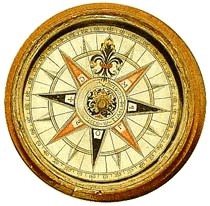(source: Prezi, author: Nicholas Chechlak)
A great follow-up is this article on Empires and Technology.
Starting in the 15th century advancement’s in methods of transportation and an increase in demand of goods from India sparked what is know as the Age of Exploration. Faster and less dangerous routes of trade, mainly with India, meant that merchants could make more money from gold, silver and spices. During this time European explorers found great new vast of land including North and South American as well as Australia. Modern methods of ship building made it possible for the European countries to begin colonizing these newly found areas and establish trade with them.
The Infoplease website has a very interesting Q&A on exploration.
==============================================
Back-up copy - the content of the passage belongs to Dorling Kindersley. No breach of copyright intended. For educational purpose only.
Copyright © 2007 Dorling Kindersley
People have always set out to discover new lands and oceans. The greatest age of world exploration began in the 15th century and lasted over four centuries. The Arabs and Chinese had already made improvements in ship design and NAVIGATION. These were now developed further by European seafarers.
Table 46. EXPLORATION
| 1405–1433 | Chinese fleets explore the Indian Ocean |
| 1486 | Diaz rounds southern Africa |
| 1492 | Columbus reaches the Caribbean |
| 1497 | John Cabot reaches Canada |
| 1498 | Columbus reaches South America |
| 1498 | Vasco da Gama sails to India |
| 1500 | Pedro Cabral reaches Brazil |
| 1522 | Magellan’s crew sails around the whole world |
| 1606 | Willem Jansz reaches Australia |
The most common reason was trade. The OLD WORLD wanted Asian spices, African ivory, and gold. European traders were soon also seizing lands and trying to convert the local populations to the Christian faith. Many explorers, though, were driven by a sense of adventure or scientific inquiry.
European countries brought many lands under their control. The world was opened up and new crops were introduced from one land to another. However, there were some disastrous effects. In the NEW WORLD, many native peoples died because they had no resistance to the European diseases that explorers and crews brought with them.
Europe, Asia, and Africa had been known to geographers since ancient times. They became known as the Old World after the European discovery of the Americas.
Navigation is any method used to find one’s way or hold a ship on course. Sailors of the 16th century had various kinds of instruments to help them cross the oceans.
Sailors used a compass to see which direction they were traveling. They could also work out a ship’s position by measuring the angle of the Sun or stars above the horizon. They did this with a metal plate called a quadrant, a disk called an astrolabe, or a simple stick called a cross-staff.
Distances traveled at sea were calculated from speed and time. To measure these, a wooden log was thrown overboard. The crew called out the time it took for the log to pass between two measuring points on the ship. The ship’s course and progress were measured on a pegboard.
“New World” was one of the terms that came to be used by Europeans to describe the newly discovered lands of North and South America.
(source: http://www.infoplease.com/dk/encyclopedia/exploration.html )
=================================================
Next week we will be talking about the Triangular Trade, so please study the text on
European maritime adventures: 1402-1460


Brak komentarzy:
Prześlij komentarz